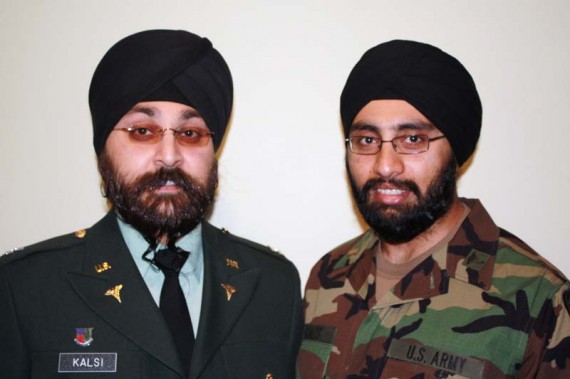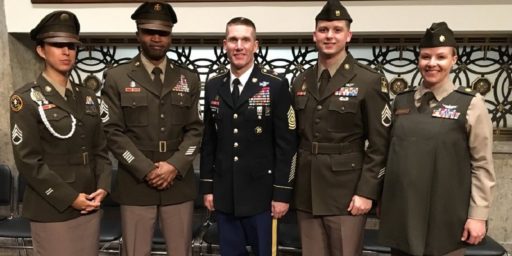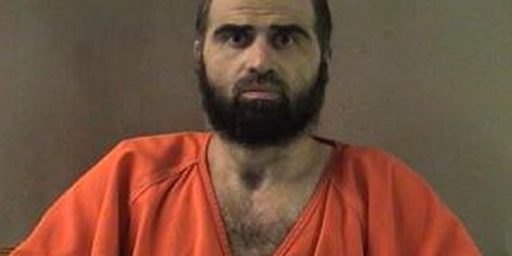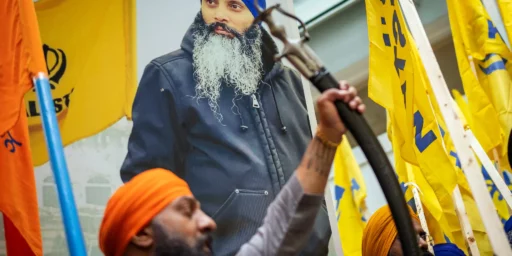Army Waives Uniform Regs for Sikhs
The United States Army has granted case-by-case exceptions to three Sikh soldiers, allowing them to serve while wearing beards and turbans.
John Burgess forwards Marcia Coyle‘s piece at Legal Times on the U.S. Army’s waiving uniform regulations to allow Sikhs to serve while wearing beards and turbans.
For the first time in more than 30 years, the U.S. military has allowed an enlisted Sikh soldier to maintain his religiously-mandated turban, beard and hair while serving in the Army.
A team of lawyers in the Washington office of McDermott Will & Emery, and attorneys at the Sikh Coalition, a community-based organization, on Wednesday successfully secured the religious right for Simran Preet Singh Lamba.
Lamba was recruited by the Army in 2009 through the Military Accessions Vital to the National Interest program for his language skills in Punjabi and Hindi. He was initially advised by an Army recruiter that his Sikh articles of faith would likely be accommodated. But the Army’s current regulations do not permit a new recruit to request a religious accommodation.
The McDermott team worked with the office of the Deputy Chief of Staff of the Army G-1 to develop a procedure through which Lamba requested an accommodation through the Army’s Human Resources Command, explained a firm spokesman. But in March, his formal request was denied.
McDermott and the Sikh Coalition then appealed to the G-1, which granted the accommodation request, after close consultation with Secretary of Defense Robert Gates and Army Secretary John McHugh.
“We have been unwavering in our assertions that Mr. Lamba’s religious requirements in no way hinder his ability to effectively serve the United States,” said Amandeep Sidhu, McDermott’s lead counsel on the case in a statement. “We remain deeply impressed with the Army’s forward-thinking approach in allowing Mr. Lamba to serve with his turban and beard, and reaffirm our call for the Army to consider amendments to its uniform policy that continues to close the door to other Sikh Americans wanting to serve in the U.S. Army.”
The two legal teams won one-time exceptions last year for two Sikh Army officers—a medical doctor and a dentist. Lamba is the first enlisted man to win the accommodation.
“This is historic, absolutely, in terms of what this means for Sikhs,” Sidhu told The National Law Journal. “The officer accommodation was clearly a big step in the right direction. The accommodation of an enlisted soldier is an even bigger step and brings us one step closer to the average Sikh being able to serve his country.”
This is an exceedingly rational decision but one that’s hard to square with the military’s impulse toward uniformity. While grooming and appearance standards are ostensibly about health, safety, and discipline they’re mostly about “looking like a soldier.” And beards have been verboten since at least WWI.
I vaguely recall soldiers wearing turbans and beards when I was a kid living on bases in the United States and Germany back in the 1970s. But the practice of granting waivers on religious grounds was ended in 1986 for a variety of reasons, with the need to get a proper seal on the protective masks that allows service members to breathe in an atmosphere contaminated with chemical and biological agents the most cited. (Oddly, however, soldiers with severe razor bumps — mostly African Americans — are routinely granted “profiles” which allow them to wear very closely trimmed beards.) Even the Navy and Coast Guard, which had a much longer tradition of sporting beards, banned them in 1985 and 1986, respectively.
But Captain Kamaljit Singh Kalsi and Second Lieutenant Tejdeep Sing Rattan, a physician and dentist, respectively, were granted waivers over the last couple of years. And, it turns out, they can get a seal on their masks just fine.
The ultimate objection, really, is cultural. As Nick Tankersley puts it, “Turbans and beards? Not in my military.” I was part of that culture long enough to share that visceral reaction. But my rationality allows me to see it for what it is and understand that it makes no sense to deny highly qualified individuals the right to serve in uniform while practicing their faith without more serious conflicts than the uniform regs. And, goodness knows, we need more soldiers with South Asian language proficiency.
The Army wants everyone to look the same — hence the uniforms — and conform to an image. Men in beards, long hair, and turbans don’t fit that image. Then again, neither do women. Yet, while they wear essentially the same uniforms, they’re allowed to wear their hair at a reasonable length — far longer than the tight taper mandated for male soldiers. And, frankly, long hair looks funny under a beret. Somehow, we’ve managed to adapt.
Also, amusingly, the Army Times photo atop the page of CPT Kalsi and 2LT T Rattan both show them in uniforms that have now been superseded in the inventory. Oddly, uniforms evolve over time. So, too, have grooming standards. If you don’t believe me, take a look at pictures of Generals George Washington, Robert E. Lee, and Ulysses Grant.







This would be a much bigger story if they were Muslims.
And I suppose that means Muslims should have a right to beards, as well?
As I understand it, Islam, in varying degrees favors beards, perhaps not to the extent of Sikhism. But in matters of personal faith, it’s hard to put the government in the spot of weighing when a tradition or custom is important enough to provide an exception.
We’re lucky to have them. The Sikhs are great soldiers as the Brits will tell you and I’ve never seen a Sikh in uniform who didn’t look very martial. The Brits have been waiving this reg for years I understand and it’s doesn’t seem to have led to a collapse of discipline or turnout standards.
Religious traditions dealing with appearances such as facial hair and headdress in this country tend to be common only to religious communities that also reject participation in the military (Hasidic Jews, Amish, Menonites, etc.), so it’s probably not an issue that has come up very often until relatively recently. Times change.
Where do they wear the sword pin?
@Joe
“The Sikhs are great soldiers as the Brits will tell you ”
You bet.
Sounds pretty damn American, if you ask me.
sam says:Friday, September 3, 2010 at 13:16
The backbone of the British Indian army were the sikh, nepalese and muslim ethnic groups. And the largest forces of Japanese engaged anywhere in WW2 were not in the Pacific as we probably all think but in Burma by the British 14th army which was majority Indian (about 50%).
The name “Gurkha” still stirs fear in many hearts even today.
Unfortunately, the natural repercussion of this is that Muslim women could expect to be allowed to wear headscarfs – and even burqas. What then?
There’s literally no doubt whatsoever that Muslims will demand special treatment – after all, it’s their well-established habit and agenda, already.
It appears that the soldier is wearing a clip-on tie, with one of the ‘wings’ showing. 20 pushups!
(retired Army bandsman speaking)
It appears that the soldier is wearing a clip-on tie, with one of the ‘wings’ showing. 20 pushups!
I think that’s part of his beard, actually. Optical delusion.
“The name “Gurkha” still stirs fear in many hearts even today.”
So does Sikh, they are fairly murderous in the right circumstances.
“The name “Gurkha” still stirs fear in many hearts even today.”
Funny Gurkha story I heard.
Officer, Brit of course, to Gurkha Sgt. Major
“Sa’Major, have men ready at ODark:Thirty. We’re jumping in from 1500 feet.”
A few minutes later, Sgt. Major returns.
“Sir, the men expressed some concern about the 1500 foot jump.”
“Don’t worry Sa’Major, we’ll have special chutes. It’ll be no problem.”
“Oh, we’ll be using parachutes. Ah, no worries, sir.”
I remember a case years ago of a female sailor that joined a fundamentalist christian church that believed that women must wear dresses only, no trousers, so she refused to wear the working uniform (dungarees). I believe she was eventually given a General Discharge.
Her parents also contacted the command asking for help getting their daughter away from what they described as “a cult.” Something like this usually goes up to high levels in the military today, with lots of lawyers (JAG) involved.
OMG!!! Turbans and Beards!!! America is doomed! Fer cryin out loud, these people want to serve their country, why shouldn’t they?
and James, for the record:
But the practice of granting waivers on religious grounds was ended in 1986 for a variety of reasons, with the need to get a proper seal on the protective masks that allows service members to breathe in an atmosphere contaminated with chemical and biological agents the most cited
There is no way for a man with a beard to get a good seal with a respirator (been there, done that) Still, if a man knows the risks, and wants to serve anyway, well, why not?.
Yeah, my primary additional duty during Desert Storm was as NBC officer. But reports I’ve seen say that the officers above managed to get through NBC training with no issue. My guess is that it’s the masks. The old M-17 masks, with the internal filters, that I used have long since been replaced with an Air Force-style mask with external cannisters. My bet is that they seal more easily around a beard.
Because the team is suddenly left a man short at the worst possible time. It’s not just his life at stake.
Richard: Yeah, those repercussions of wanting equal protection under the law… Just nasty, I tell you. A suicide pact or something.
I wish the military could bring a little enlightenment to Seattle. Lately the hate crimes directly correlate to national elections.
http://www.seattlepi.com/local/425902_clerk30.html
http://www.sikhcoalition.org/advisories/SukhvirSeatteHateCrime.htm
You may be thinking of Sepoys not Gurkhas – the latter are Nepalis. Common mistake.